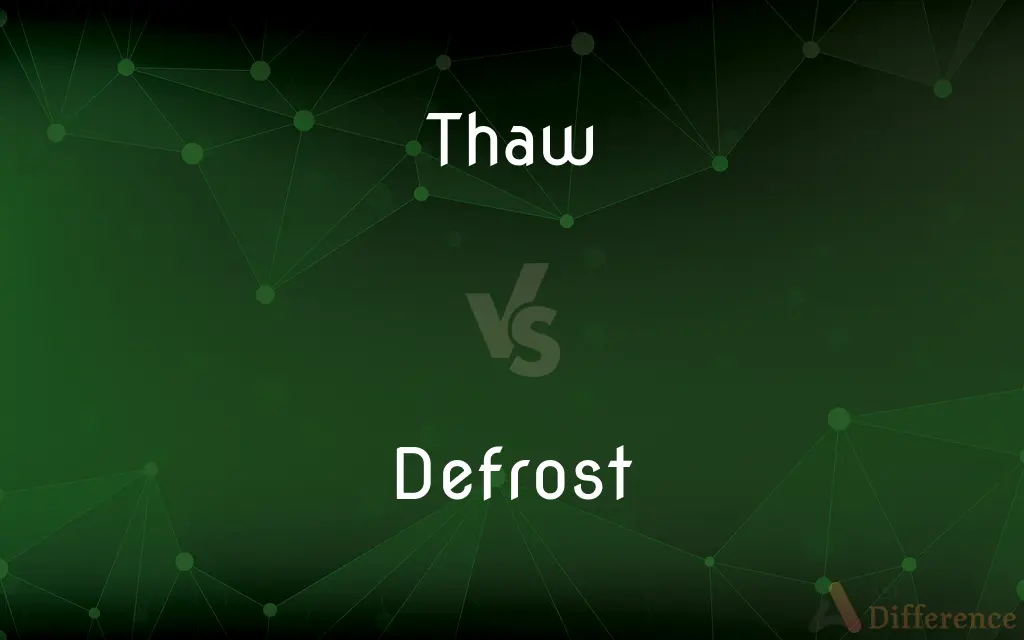Thaw vs. Defrost — What's the Difference?
Edited by Tayyaba Rehman — By Fiza Rafique — Updated on March 4, 2024
Thaw and defrost refer to the process of something changing from frozen to unfrozen state, but thaw often applies more broadly to natural processes and environments, and defrost is commonly used for deliberate actions, in relation to food or appliances.

Difference Between Thaw and Defrost
Table of Contents
ADVERTISEMENT
Key Differences
Thawing is a natural or induced process where ice, snow, or frozen materials return to their liquid or original state. This can occur due to environmental changes, such as warmer temperatures causing snow and ice to melt in nature. On the other hand, defrosting specifically refers to the removal of frost or ice, and it's often used in a more controlled context, such as defrosting food or clearing the build-up of ice in freezers and refrigerators.
While thawing can happen under ambient conditions without human intervention, defrosting usually involves an active process or device. Thawing might be preferred to describe the gradual warming and melting of frozen ground or water bodies, indicative of passive or natural processes. Conversely, defrosting is a term frequently found in culinary and appliance contexts, where it implies a deliberate effort to make frozen items usable or to maintain the efficiency of freezers and cooling devices.
The terms also differ in their usage across various contexts. Thawing is applicable in broader scenarios, including environmental changes, weather patterns, and even metaphorically to describe the easing of tensions in relationships or negotiations. Defrosting, however, is more narrowly defined and is commonly associated with specific tasks, such as preparing frozen food for cooking or maintaining appliances. This distinction highlights the versatility of "thaw" and the specificity of "defrost" in everyday language.
The speed and method of the transition from frozen to unfrozen states can vary between thawing and defrosting. Thawing, especially in natural settings, is subject to environmental conditions and may take longer. Defrosting, particularly when referring to food or appliances, is often achieved through specific methods intended to expedite the process, such as using warm water for food or built-in defrost functions in appliances.
Despite these differences, both processes ultimately serve to change the state of a substance from solid (frozen) to liquid or to its unfrozen state, facilitating its use, whether it be for consumption, utility, or environmental balance.
ADVERTISEMENT
Comparison Chart
Definition
Transition from frozen to unfrozen state, naturally or induced.
Actively removing frost or ice, especially from food or appliances.
Common Usage
Natural processes, environmental changes.
Food preparation, appliance maintenance.
Method
Ambient conditions, gradual warming.
Active process, using devices or techniques.
Context
Broad (environmental, metaphorical).
Specific (culinary, appliances).
Speed
Variable, often slower.
Usually quicker, method-dependent.
Compare with Definitions
Thaw
The process of ice melting in the environment.
The thaw after the long winter revived the plants.
Defrost
Using a device or method to expedite melting.
Use the microwave's defrost setting for quick thawing.
Thaw
To become liquid or soft after being frozen.
The river begins to thaw in early spring.
Defrost
To remove ice from a freezer or refrigerator.
It's time to defrost the freezer; it's full of ice.
Thaw
Gradual warming of relations or feelings.
The negotiations led to a thaw in diplomatic relations.
Defrost
The process of making frozen food ready to cook.
Defrost the chicken in the refrigerator overnight.
Thaw
To permit frozen things to warm up naturally.
Let the meat thaw completely before cooking.
Defrost
To clear frost or ice from a vehicle's windshield.
He used the car's defrost function to clear the windshield.
Thaw
Natural melting of frozen ground.
The thaw made the roads muddy and difficult to traverse.
Defrost
Actively warming frozen items for use.
Defrost the berries for the smoothie.
Thaw
To change from a frozen solid to a liquid by gradual warming.
Defrost
To become free of ice or frost
A freezer that defrosts automatically.
Thaw
To lose stiffness, numbness, or impermeability by being warmed
Left the frozen turkey out until it thawed.
Thawed out by sitting next to the stove.
Defrost
To remove the frost or ice from; as, to defrost the car window; to defrost a refrigerator.
Thaw
To become warm enough for snow and ice to melt.
Defrost
To become free of frost or ice; as, it took four hours for the refrigerator to defrost.
Thaw
The melting of ice, snow, or other frozen or congealed matter; the transformation of ice or the like into the state of a fluid; liquefaction by heat of anything congealed by frost
Defrost
Make or become free of frost or ice;
Defrost the car window
Thaw
To melt, dissolve, or become fluid; to soften; - said of that which is frozen; as, the ice thaws.
Thaw
The melting of ice, snow, or other congealed matter; the resolution of ice, or the like, into the state of a fluid; liquefaction by heat of anything congealed by frost; also, a warmth of weather sufficient to melt that which is congealed.
Thaw
The process whereby heat changes something from a solid to a liquid;
The power failure caused a refrigerator melt that was a disaster
The thawing of a frozen turkey takes several hours
Thaw
Become or cause to become soft or liquid;
The sun melted the ice
The ice thawed
The ice cream melted
The heat melted the wax
The giant iceberg dissolved over the years during the global warming phase
Dethaw the meat
Common Curiosities
Does thawing only apply to water or ice?
While commonly associated with water or ice, thawing can also metaphorically apply to the easing of tensions or feelings.
What does it mean to thaw food?
Thawing food means allowing it to transition from frozen to unfrozen state, typically at room temperature or in a refrigerator.
Can thaw happen without human intervention?
Yes, thawing can occur naturally, such as ice and snow melting due to warmer weather.
How is defrosting a freezer different from thawing?
Defrosting a freezer is a deliberate action to remove ice buildup, whereas thawing can occur naturally and applies to broader contexts.
Is it safe to thaw food at room temperature?
Thawing food at room temperature is not recommended for safety reasons; using a refrigerator is safer.
Why is defrosting important for food preparation?
Defrosting food is crucial for cooking, as it ensures even cooking and the safety of the food.
What appliances commonly have a defrost function?
Many microwaves and freezers have a defrost function designed to expedite the thawing process.
How does thawing affect the environment?
Thawing, especially of permafrost, can have significant environmental impacts, including releasing greenhouse gases.
Why do some recipes require food to be defrosted first?
Defrosting ensures that food cooks evenly and prevents the growth of harmful bacteria.
What role does thaw play in spring ecosystems?
Thaw contributes to the revival of plant and animal life by providing necessary water and warmer temperatures.
What is the best method to thaw frozen meat?
The best method is to thaw it in the refrigerator to ensure safety and preserve quality.
What safety precautions should be taken when defrosting food?
Defrost food in the refrigerator, under cold water, or in the microwave, and cook it immediately after thawing to prevent bacterial growth.
Can defrosting be done quickly?
Yes, defrosting, especially using specific methods or appliances, can be done relatively quickly compared to natural thawing.
How often should I defrost my freezer?
It depends on the appliance and ice buildup but generally once a year or when the ice thickness exceeds 1/4 inch.
Can thawing and defrosting be used interchangeably?
While often used interchangeably, especially regarding food, they have different connotations in broader contexts.
Share Your Discovery

Previous Comparison
Ramble vs. Rattle
Next Comparison
Impasse vs. StalemateAuthor Spotlight
Written by
Fiza RafiqueFiza Rafique is a skilled content writer at AskDifference.com, where she meticulously refines and enhances written pieces. Drawing from her vast editorial expertise, Fiza ensures clarity, accuracy, and precision in every article. Passionate about language, she continually seeks to elevate the quality of content for readers worldwide.
Edited by
Tayyaba RehmanTayyaba Rehman is a distinguished writer, currently serving as a primary contributor to askdifference.com. As a researcher in semantics and etymology, Tayyaba's passion for the complexity of languages and their distinctions has found a perfect home on the platform. Tayyaba delves into the intricacies of language, distinguishing between commonly confused words and phrases, thereby providing clarity for readers worldwide.















































